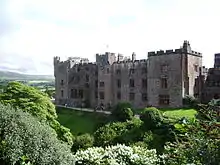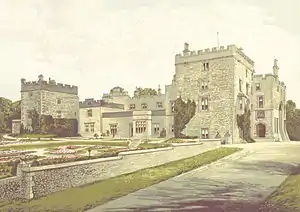
Muncaster Castle is a privately owned castle overlooking the River Esk, about a mile east of the west-coastal town of Ravenglass in Cumbria, England. It is recorded in the National Heritage List for England as a designated Grade I listed building.[1]
History

The place is now corruptly known as "Muncaster", which first appeared in a Cumberland church register in 1577, the original name according to all old evidence and records being "Mulcaster", registered in the pipe rolls of Cumberland circa 1150 (also as Molecaster and Mulecaster in 1190 and 1236 respectively).
The placename "Muncaster" contains the Latin word castra, meaning "encampment", or "fort".[2] It is suspected that the site of the castle lies on foundations dating to the Roman era, which, if they exist, may represent a castellum for the nearby Roman fort of Glannoventa at Ravenglass.[3]
The Muncaster estate was granted to Alan de Penitone in 1208. The oldest parts of the castle include the Great Hall and the 14th-century pele tower, a type of watch-tower fortification unique to the English-Scottish border region.
Between 1860 and 1866 Anthony Salvin extensively remodelled Muncaster Castle for the Barons Muncaster.[4] Sir John Frecheville Ramsden, 6th Baronet discussed proposed modifications to the castle with Edwin Lutyens from 1916, but nothing came of these; Lutyens did design the Muncaster War Memorial, constructed in 1922, on a commission from Ramsden.[5]
Muncaster's gardens include features designed to take advantage of views of the Esk Valley and the mountains.[6] There is an aviary containing owls and other raptor birds from Britain and overseas. There are daily flying displays of these birds. There is an indoor maze themed on the life of a field vole.[7]
Muncaster Castle is still owned by the Pennington family, who have lived at Muncaster for at least 800 years, and a family residence.[8] Until her death in 2011, Phyllida Gordon-Duff-Pennington and her husband Patrick Gordon-Duff-Pennington (1930–2021) worked for three decades to restore the castle from a "crumbling relic" and establish it as a place for tourism and events. Since 2021, the owners are Peter and Iona Frost-Pennington, with their elder son Ewan the "Muncaster's operations director".[9] It now has more than 90,000 visitors a year.[10]
In October 2021, the castle was one of 142 sites across England to receive part of a £35-million injection into the government's Culture Recovery Fund.[11]
Muncaster hosts the Muncaster Castle parkrun 5k every Saturday morning at 0900.
The Luck of Muncaster
After the Battle of Towton in 1461, according to tradition, Henry VI fled to Muncaster Castle where Sir John Pennington sheltered him. Henry gave Sir John a Venetian glass drinking bowl, with a wish: "As long as this bowl remains unriven, Penningtons from Muncaster never shall be driven".[9] The glass, which is still intact, and still at the castle, is now known as "The Luck of Muncaster".[12]
Tom Fool
Each year the castle recruits its own jester in the culmination of a competition that celebrates the art of tomfoolery. The last jester, named Thomas Skelton, whose full-length portrait hangs at the castle, is believed to be the original Tom Fool, who is often said to have inspired Shakespeare's Fool in King Lear. Legend has it that Skelton was enlisted by Wild Will of Whitbeck to behead a carpenter's son, Dick, a servant at the castle, who was an unwanted suitor of his betrothed, Helwise Pennington, the unmarried daughter of Sir Alan Pennington. He is rumoured to have said, "There, I have hid Dick’s head under a heap of shavings; and he will not find that so easily, when he awakes, as he did my shillings."[13][14]
See also
References
Citations
- ↑ Historic England. "Muncaster Castle (1068780)". National Heritage List for England. Retrieved 1 October 2012.
- ↑ "Latin Word Lookup". Catholic.archives.nd.edu. Archived from the original on 15 April 2012. Retrieved 4 April 2012.
- ↑ "Ruins of a Roman Bath and the Foundations of a Castle – Ravenglass and Muncaster". 30 April 2015.
- ↑ Emery 1996, p. 232.
- ↑ Historic England. "Muncaster War Memorial and area wall (1086636)". National Heritage List for England. Retrieved 7 September 2016.
- ↑ Historic England. "Muncaster Castle Gardens (1000669)". National Heritage List for England. Retrieved 1 October 2012.
- ↑ "Hawk & Owl flying displays at Muncaster Castle". Muncaster Castle. Retrieved 2 June 2022.
- ↑ Goddard, Donald (28 July 1985). "It's All in the Family at Muncaster". The New York Times. Retrieved 12 December 2017.
- 1 2 Pidd, Helen (26 February 2023). "'It's a bit too castle-y': plans to turn Cumbrian fortress into eco-attraction". The Guardian. Retrieved 3 March 2023.
- ↑ "Obituary: Phyllida Gordon-Duff-Pennington, châtelaine". The Scotsman. 31 May 2011. Retrieved 12 December 2017.
- ↑ "Heritage and Craft Workers Across England Given a Helping Hand" – Historic England, 22 October 2021
- ↑ "Muncaster – Monument to Henry VI". Archived from the original on 9 November 2012. Retrieved 27 February 2012.
- ↑ "Jester competition reveals dark past". 30 May 2013 – via www.bbc.co.uk.
- ↑ "Thomas Skelton: the murderous jester of Muncaster Castle". 15 November 2016.
Sources
- Emery, Anthony (1996), Greater Medieval Houses of England and Wales, 1300–1500, Volume I: Northern England, Cambridge: Cambridge University Press, ISBN 9780521497237
External links
- Muncaster Castle website
- Gatehouse Gazetteer record for Muncaster Castle, containing a comprehensive bibliography
- Muncaster Castle and Ravenglass Bath House